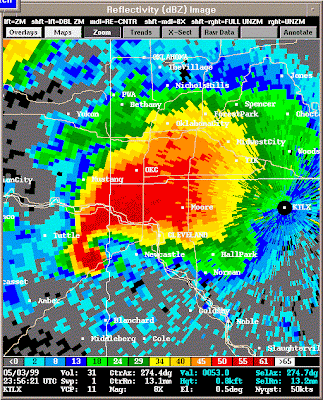 There it is, at the lower left of the red blotch, a classic hook echo. That is the radar signature of the May 3, 1999 Oklahoma City tornado-laden supercell. This image is from a descriptive web page here, which includes more images and storm maps of the fifty-tornado outbreak that day. This particular tornado developed into an F5, the strongest class of tornado, with winds in the 250-mph (400 kph) range. Its path of destruction on the ground was a mile wide.
There it is, at the lower left of the red blotch, a classic hook echo. That is the radar signature of the May 3, 1999 Oklahoma City tornado-laden supercell. This image is from a descriptive web page here, which includes more images and storm maps of the fifty-tornado outbreak that day. This particular tornado developed into an F5, the strongest class of tornado, with winds in the 250-mph (400 kph) range. Its path of destruction on the ground was a mile wide.More than 100 years ago, Mark Twain wrote, "Everybody talks about the weather, but nobody does anything about it." Mike Smith is one person who has been doing something about it, for decades now. As he writes in Warnings: The True Story of How Science Tamed the Weather, from a "beginning involving spare World War II leftovers, we have developed an effective and highly cost-effective system that saves lives and dollars, nearly every week." He is writing about the system of weather tracking radar, weather spotting persons and equipment, and meteorology professionals that work together to forecast and warn of severe weather wherever (in the US) it occurs.
While weather modification has so far been pretty much a failure, the watch and warning system that Smith and others developed since the 1960s is a great example of doing what you can do. In this case, if you can't change the weather, at least you can get out of the way.
Starting at age five when he and his family lived through a tornado in their Kansas City, Missouri neighborhood, Mike Smith knew he wanted to study the weather. As time passed, he witnessed firsthand the devastation that results when severe weather hits without warning. For many years, the official stance of the National Weather Service was not to mention words like "tornado", so as to avoid panic. There was a ban against it. Then in 1955, the town of Udall, Kansas was hit by a nighttime tornado that pretty much erased the town, killing 82 and injuring 260 of the 500 residents. It is called the "town that died in its sleep." Not long after that, on-air meteorologists issued a tornado warning, and the ban began to lift. It didn't take long to find out that most people don't panic; they take a warning well and move to rescue themselves in a remarkably calm way. The warning system gradually developed into today's graded messages, where a "watch" means severe weather is forecast to arrive soon, and a "warning" means it has been seen.
Smith recounts story after story of the gradual shift in attitudes, and of the developing technology. Early radar equipment, scavenged from WWII salvage yards, was able to show you the location and size of a storm, as long as the rain wasn't too strong right around the antenna. It worked best from about fifty miles away, but later problems showed that forecasters need to be where the screens are. Co-location of equipment and forecasters has been the norm for more than twenty years. The development of doppler radar in the 1980s was difficult enough as a technical and engineering challenge. But the bureaucratic roadblocks were much more severe! The author's disdain for a government's way of doing things forms a heartbeat of the book.
This thread is strongest in the chapter about Hurricane Andrew and the three chapters devoted to Hurricane Katrina. Andrew showed us just how damaging a Category 5 hurricane could be. Katrina showed us that the "powers that be" had learned nothing from Andrew. Smith is particularly disdainful of the criminally inept performance of the two governors and the New Orleans mayor. Come to think of it, this is the only major piece of writing about the Katrina disaster that puts the blame where it lies, rather than mostly upon President Bush. Though he does get his share of the blame, the President was a lesser player next to those who should have acted and either did nothing or actively hindered those who were willing to help!
The book ends with the tragic but heartening tale of the destruction of Greensburg, Kansas in 2007. This was another F5 tornado like the one that hit Udall. It was 1.7 miles wide; so was the town, and the tornado hit dead center, as the Udall tornado had. Proportionally (Greensburg's population is 1,500), more than 240 people could have died. The death toll was eleven, and injuries were also few. What a difference a few decades of progress have made!
Until somebody invents the Handy Dandy Hurricane and Tornado Stopper and Flood Tamer, the best we can do is to take heed to warnings and get out of the way. Our ability to obtain warnings and other weather data, now at the click of a mouse or flick of a 'phone, is due to the efforts of Mike Smith and his colleagues over the past forty-plus years. I wonder what the next forty will bring?



No comments:
Post a Comment